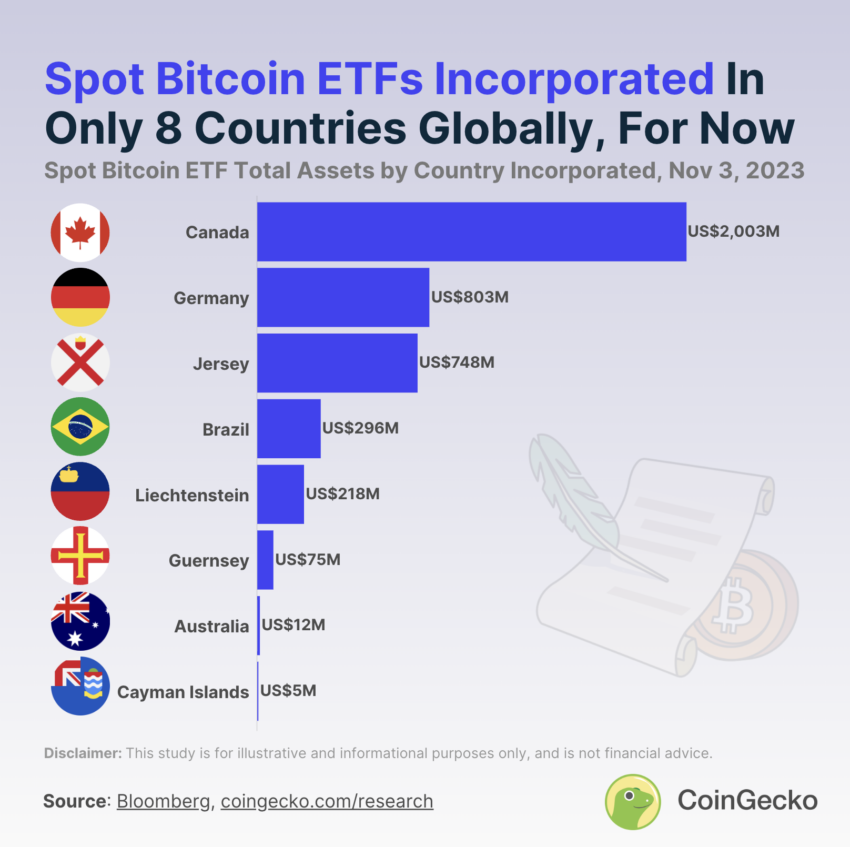The crypto industry is experiencing a paradigm shift with the emergence of Spot Bitcoin ETFs (Exchange-Traded Funds). According to recent data, assets invested in Spot Bitcoin ETFs have reached a cumulative value of $4.16 billion worldwide.
This is a testament to the growing acceptance of these innovative financial instruments that offer retail and institutional investors a regulated pathway into Bitcoin.
These Are All the Bitcoin ETFs Worldwide
Canada is a pioneering nation in this sector, hosting seven Spot Bitcoin ETFs with a total investment of $2 billion. The spotlight shines brightly on the Purpose Bitcoin ETF, the largest globally, with $819.1 million in assets. Indeed, this ETF is a beacon of Canada’s progressive stance towards cryptocurrency integration within its financial ecosystem.
Europe, led by Germany, has also shown a more open regulatory approach. The ETC Group Physical Bitcoin, launched in June 2020, now boasts $802 million in assets, making it the second-largest Spot Bitcoin ETF globally. Moreover, seven other European ETFs find their homes in tax-friendly jurisdictions, further cementing Europe’s evolving crypto-friendly ecosystem.

As of now, only eight countries worldwide have embraced Spot Bitcoin ETFs. These include G20 nations Canada, Germany, Brazil, Australia, and tax havens Jersey, Liechtenstein, Guernsey, and the Cayman Islands.
The global distribution of Spot Bitcoin ETFs paints a vivid picture of how nations are positioning themselves within the crypto market.
On the other hand, the United States maintains a conservative stance. The US Securities and Exchange Commission (SEC) has approved only ETFs tied to Bitcoin futures contracts. For instance, the ProShares Bitcoin Strategy is leading the charge with about $1.2 billion in assets.
US Bitcoin ETF Approval Could Be Huge
Despite the awaiting approval of as many as 10 applications for Spot Bitcoin ETFs, the SEC’s concerns around market manipulation remain a significant roadblock.
“I’m not going to prejudge the staff’s work on those multiple ETFs filings, but it’s also about those companies. When a company, or an asset manager, is seeking to take something public, these exchange-traded products need to be registered with the SEC and they go through a filing somewhat similar to going public like an IPO, and so it is really the work of our division of corporation finance that gives feedback and looks at the filings,” Gary Gensler, SEC Chairman, said.
The debate further heats up when the focus shifts to the potential US Spot Bitcoin ETF market. According to experts, could experience a surge with estimates starting at $1 billion or more in first-day demand.
The anticipation around the SEC’s decision on the pending Spot Bitcoin ETF applications is thick, with a potential to propel the US into the forefront of this sector.
“We could expect $155 billion will flow into the Bitcoin market once these ETFs are approved. The total Assets Under Management (AUM) of these companies are around $15.6 trillion. If they were to put 1% of their AUM into these Bitcoin ETFs, the total US dollar amount that would enter the Bitcoin market would be around $155 billion. To put it in context, these amounts represent almost a third of the current market capitalization of Bitcoin,” blockchain analytics firm CryptoQuant reported.
Looking ahead, the SEC’s decision on the pending Spot Bitcoin ETF applications could be a watershed moment. Therefore, potentially unlocking a new chapter in the crypto industry.
“We expect US regulated ETFs to be the watershed moment for crypto and we expect a SEC approval by late 2023/Q1, 2024. Post halving, we expect the Bitcoin spot demand via ETFs to outstrip miner selling by 6-7 times at peak. We expect Bitcoin ETFs to be equivalent to 9-10% of spot Bitcoin in circulation by 2028,” Gautam Chhugani, Global Digital Senior Analyst at Bernstein, said.
 beincrypto.com
beincrypto.com
